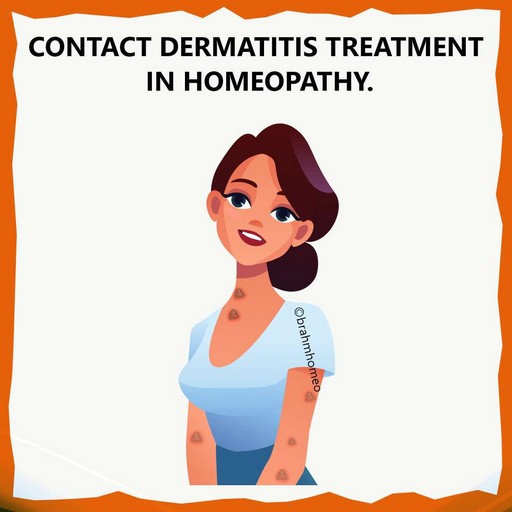
Contact Dermatitis treatment in homeopathy
Contact dermatitis is a red, itchy rash caused by direct contact with a substance or an allergic reaction to it. The rash isn't contagious or life-threatening, but it can be very uncomfortable.
Many substances can cause such reactions, including soaps, cosmetics, fragrances, jewelry and plants.
Symptoms
Contact dermatitis usually occurs on areas of your body that have been directly exposed to the reaction-causing substance. The rash usually develops within minutes to hours of exposure and can last two to four weeks.
Signs and symptoms of contact dermatitis include:
· A red rash
· Itching, which may be severe
· Dry, cracked, scaly skin
· Bumps and blisters, sometimes with oozing and crusting
· Swelling, burning or tenderness
Causes
Contact dermatitis is caused by a substance you're exposed to that irritates your skin or triggers an allergic reaction. The substance could be one of thousands of known allergens and irritants. Some of these substances may cause both irritant contact dermatitis and allergic contact dermatitis.
A) - Irritant contact dermatitis is the most common type. This non allergic skin reaction occurs when a substance damages your skin's outer protective layer.
Some people react to strong irritants after a single exposure. Others may develop signs and symptoms after repeated exposures to even mild irritants. And some people develop a tolerance to the substance over time.
Common irritants include:
· Solvents
· Rubbing alcohol
· Bleach and detergents
· Shampoos, permanent wave solutions
· Airborne substances, such as sawdust or wool dust
· Plants
· Fertilizers and pesticides
B)-Allergic contact dermatitis occurs when a substance to which you're sensitive (allergen) triggers an immune reaction in your skin. It usually affects only the area that came into contact with the allergen. But it may be triggered by something that enters your body through foods, flavorings, medicine, or medical or dental procedures.Once you develop an allergy to a substance, even a small amount of it can cause a reaction.
Common allergens include:
· Nickel, which is used in jewelry, buckles and many other items
· Medications, such as antibiotic creams and oral antihistamines
· Balsam of Peru, which is used in many products, such as perfumes, cosmetics, mouth rinses and flavorings
· Formaldehyde, which is in preservatives, disinfectants and clothing
· Personal care products, such as deodorants, body washes, hair dyes, cosmetics and nail polish
· Plants such as poison ivy and mango, which contain a highly allergenic substance.
· Airborne substances, such as ragweed pollen and spray insecticides
· Products that cause a reaction when you're in the sun (photoallergic contact dermatitis), such as some sunscreens and oral medications
Children develop the condition from the usual offenders and also from exposure to diapers, baby wipes, sunscreens, clothing with snaps or dyes, and so on.

Risk factors
Some jobs and hobbies put you at higher risk of contact dermatitis. Examples include:
· Health care and dental employees
· Metalworkers
· Construction workers
· Hairdressers and cosmetologists
· Auto mechanics
· Scuba divers or swimmers, due to the rubber in face masks or goggles
· Cleaners
· Gardeners and agricultural workers
· Cooks and others who work with food
Diagnosis
Our doctor will perform a physical examination, take a medical history, and possibly recommend the following tests:
· Allergy blood test. A blood sample is sent to a lab to measure your immune system's response to a specific allergens.This test measures the amount of allergy-causing antibodies in your bloodstream, known as immunoglobulin E (IgE) antibodies.
It is curable with homeopathic treatment. Since how long you are suffering from disease, has to do a lot with treatment plan. No matter, since when are you suffering from your disease either from recent time or since many years everything is curable with us but in early stage of disease, you will be cured faster. For chronic conditions or in later stage or in case of many years of suffering, it will take longer time to be cured. Intelligent person always start treatment as early as he /she observe any sign and symptom of this disease, so immediately contact us as soon as you observe any abnormality in you.
How we work on this disease
Brahm research based, clinically proved, scientific treatment module is very effective in curing this disease. We have a team of well qualified doctors who observe and analysis your case systematically, record all the signs and symptoms along with progress of disease, understand its stages of progression, prognosis and its complications. After that they clear you about your disease in details, provide you proper diet chart [what to eat or what not to eat], exercise plan, life style plan and guide you about many more factors that can improve your general health condition with systematic management of your disease with homeopathic medicines till it get cured.


















